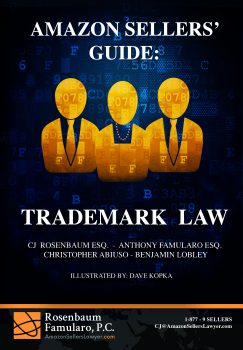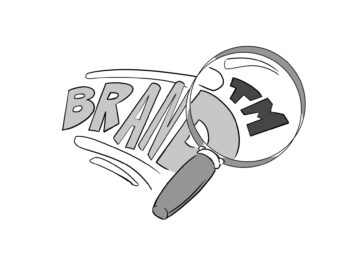
Amazon Sellers’ Guide: Trademark Law
Chapter 1: When Should a Trademark Be Pursued & When is it Best to Walk Away?
What is a Trademark?
Keurig. Starbucks. Barilla. McDonalds. Tide… These five trademarks (all of them are word marks) all bestow certainty upon the goods and services associated with them – certainty in quality, standards, uses, and, indeed, even what types of goods and services may be generally expected.
• Keurig’s machines are compatible with K-cups;
• Starbucks is associated with fast and dependable service and particular, rather strong, coffee;
• Barilla sells respectable Italian pastas and sauces at a reasonable price;
• McDonalds has specific tasting burgers and fries;
• Tide will never be expected to move into producing food items.
 Trademarks are an old and established tradition in the realm of merchants and commerce. In fact, the earliest “trademarks” date back to 5000 B.C. in China, where pottery was stamped with the location of its creation and its manufacturer.
Trademarks are an old and established tradition in the realm of merchants and commerce. In fact, the earliest “trademarks” date back to 5000 B.C. in China, where pottery was stamped with the location of its creation and its manufacturer.
In ancient Egypt, craftsmen affixed unique symbols to their goods so buyers would be able to easily determine the product’s origin.
Over time, this tradition of marking goods with the symbol or signature of their point of origin expanded to encompass all of Europe, growing particularly prominent in the middle ages. King Edward I of England, in the 12th century, enacted a law which made it illegal for a jeweler to sell a piece of jewelry lacking the stamp of the royal office known as the Goldsmith’s Hall. The punishment for counterfeiting this mark was death.
Although these early proto-trademarks were not the fully-fledged trademarks of today, they fulfilled the function of preventing fraudulent products from being developed and distributed.
The modern trademark saw its first use in its earliest form in the time between the 13th and 16th centuries as the merchant mark. Trade guilds used specific marks to indicate the origin of their goods, first by bell makers and then by paper makers.
Southern v. How, an English case from 1618, is generally regarded as the earliest known court case involving trademark infringement, which came about when a low-tier clothmaker used a mark which was legally reserved for high-tier clothmakers.
Trademarks have grown so prevalent that they have seemingly come to define not just the manufacturers of goods, but products themselves. Instead of relying on what judges rule on from case to case, merchants depend on the Lanham Act, which was signed into law 1946, to offer legal armor against infringing parties, by introducing a series of laws meant to protect the sanctity of trademarks. Grocery store shelves, magazines, and television advertisements are filled to the brim with an endless stream of trademarks used by sellers to promote and sell their particular brand of product. Mentally, it has become very easy for what began as an indication of product origin to become a label for the product itself.
Thinking that a trademark defines the product is a mistake. Trademarks do not describe the goods in question. If that were the case, Apple products purchasers would be disappointed, indeed, to see a phone or laptop in their packages and not pieces of fruit. A more accurate explanation is that trademarks identify the origin of goods to consumers; in other words, they identify the Seller. All of his or her good nature, dependability, the overall quality of the goods he or she produces, and even his or her public image can be directly applied to the trademark. Any product bearing this trademark, in effect, affirms to consumers that they are guaranteed the same generalized standards of quality and care that have been demonstrated in the past by goods advertised by or labeled with such a trademark. It grants to consumers a sense of security in that the product they are purchasing will not stray too far from what they have thus far expected.
Although trademarks may seem dedicated to consumer protection, they are also fundamental to establishing the Seller’s territory of business, from geographic location, to product category, to the particular type of product, to the assurances the Seller can typically guarantee to consumers. An effective trademark is a means of identifying and separating the Seller’s goods from those of competitors, or even those who are not directly competitors but with whom association would injure the Seller’s image. Imagine, for example, the effect on the public opinion of the dog food company Alpo if another company specializing in rat poison was able to brand their products with the “ALPO” logo. Besides the obvious and distressing consequences which would befall consumers who become confused by such labeling, Alpo would also have a huge problem; they would seemingly be associated with a brand of rat poison. They would have to contend with an endless stream of questions as consumers, some of whom having potentially bought Alpo dog food before, ask them, “Are you selling rat poison now? Is there a risk of contamination with the dog food? Will your quality slip now that you are focusing on both dog food and rat poison?” Even if Alpo fielded and answered every single question with the answer that they are not associated with “ALPO,” “ALPO” will continue to sell rat poison while Alpo continues to deal with an intense identity crisis in trying to reach and educate other newly-confused consumers that Alpo is not “ALPO” and is not even associated with “ALPO.” If that last sentence confused or frustrated you, consider yourself in the shoes of a similarly confused or frustrated consumer. This is the confusion and frustration which a trademark will work to prevent.
Justice Pitney once said that trademarks “designate … goods as the product of a particular [seller] and … protect his [or her] good will against the sale of another’s product as his [or hers].”
As such, trademarks are a form of protection for not only consumers but also sellers. Without them, a Seller’s goods could easily be attributed to another individual selling similar goods. This false Seller may hijack the sweat of the Seller’s brow and abuse the good nature he or she has worked to foster. This false Seller may sell inferior goods which are then mistakenly attributed to the legitimate Seller, injuring his or her reputation. Designing and using a trademark to designate a seller’s goods as coming from that Seller and that Seller alone may therefore appear to be good idea. However, before being drafted and used, a trademark must be the first of its kind to be used; in other words, it must have priority. What’s more, it must satisfy a number of other legal requirements before its full protective power can be enjoyed.
Geographic Zones: When to Commit to a Trademark & When to Take a Step Back

A trademark would be worthless if any newcomer could register a mark that is similar to a mark that already exists. When a seller is deciding on a trademark to use, therefore, it is important to ensure that another existing trademark does not have priority. That is to say, the Seller’s prospective trademark must be the first in commercial use within its geographic area.
Typically, a trademark which is unregistered with the United States Patent and Trademark Office (“USPTO”) will be limited to a general geographic area where the consumer base will be able to identify the mark as representing a particular source. This geographic area is called the “zone of goodwill.” A seller’s zone of goodwill is comprised of both the zone of market penetration (regions where consumers have purchased products bearing the mark) and the zone of reputation (regions where consumers know about the seller’s products). Further, to gain trademark protection in the zone of goodwill, a Seller must demonstrate that their mark has been used in commerce by showing the volume of sales in the area, the growth trends in that area, the number of customers in relation to the number of actual customers in the area, and the advertising present within the area. A trademark that satisfies these requirements and is the first of its kind to be used in the zone of goodwill, will have legal priority over any newcomers who will be infringing on the senior patent if they decide to enter the market without priority.
Much like brick-and-mortar merchants, internet sellers who are attempting to form and use a trademark will need to worry about another trademark holding priority over theirs in the desired geographic area. Like Sellers who sell a majority of their merchandise in physical locations, internet sellers must keep in mind the market penetration and reputation of competitors and their potentially prioritized trademarks to determine what areas may be off limits for to their own trademark. Market penetration for an internet seller may be easily determined by looking at the number and distribution of total sales made by the internet Seller. Although imperfect, reputation can at least be estimated by reviewing the number of views from each geographic location the Seller would like to deploy the trademark in.
CJ’s Tip: When you’re creating a trademark for your brand, it’s always good practice to know when to put it into use and when to walk away. You shouldn’t spend too much time or effort on designing and employing a particular trademark if you know it will probably be blocked by a preexisting mark. If, after checking the area or the Gazette (discussed in later chapters), and you think it would be impossible to avoid infringing on another’s mark, it’s always easier to take a step back and redesign your mark than to cast the die and hope your trademark won’t step on any toes. If you don’t take the time to check the Gazette or the area you want to deploy your trademark in for a preexisting mark, you will probably be surprised when you receive a cease and desist order, or even worse, a legal complaint.
Reviewing the zone of goodwill of competitors before filing a trademark to avoid infringement should, of course, always be done. However, if the Seller, for whatever reason, has no plans to pursue registration of his or her trademark, it may be beneficial to perform regular checks of his or her own zone of goodwill to measure the geographic area his or her trademark covers. In this way, not only will the internet Seller avoid infringing any existing trademarks, but he or she will also be able to more readily determine his or her zone of goodwill for the purposes of protecting his or her own territory. This book will go deeper into watching and protecting a trademark from infringement in chapter 8.
In addition to the above, also of importance in determining the geographic zone in which to deploy one’s trademark, is the predicted zone of expansion for the business. This zone of expansion can be determined by first looking at whether the owner of the mark holds a valid trademark. Next an observer should evaluate: the physical distance from the trademark user’s location to the perimeter of the claimed zone; the business and size of the market; the history of expansion and estimation of when the user could reach the zone in question; and whether the expansion into the zone would be the next probable step for the business’s expansion. Because of the widespread nature of the internet, it has been noted that the zone of expansion for internet sellers may in fact be larger and quicker to grow. This is because the internet is available to so many people at once and it would be easier to assume that the internet seller will be able to expand to a larger number of people than a brick-and-mortar store.
Anthony’s Breakdown: When dealing with trademark priority issues, you may come across the concept of tacking. Tacking is where a party “tacks” or “saves” the date of the original mark onto a subsequent mark for purposes of establishing priority. However, the two marks must be so similar that consumers would typically regard them as the same. For example, if McDonald’s started a subsequent business under the mark “McRonald’s” as a cardiologist office to fix the hearts of people who eat too many Big Mac’s, they would be able to tack the new mark to the date they registered “McDonald’s” for trademark. This is because the marks are so similar that any average person would recognize the subsequent mark as part of McDonald’s business. This is a fairly advanced and rare concept to deal with, but it may come in handy to know if you ever want to draft a new trademark and don’t want to start fresh with its priority.
The theory and practice of establishing and maintaining a trademark may seem daunting at first, but it is important to keep abreast of it to maintain a solid brand. The chapters that follow will make both the theory and practice of trademarks, as applied to internet sellers, much easier to comprehend.

For a free copy of one of our books, email us today: CJ@AmazonSellersLawyer.com
- https://amazonsellerslawyer.com/your-guide-to-amazon-suspensions/
- https://amazonsellerslawyer.com/amazon-sellers-guide-trademark-law/
- https://amazonsellerslawyer.com/amazon-sellers-guide-copyright-law/
- https://amazonsellerslawyer.com/amazon-sellers-guide-chinese-intellectual-property-law/
- https://amazonsellerslawyer.com/amazon-law-library/
- https://amazonsellerslawyer.com/your-guide-to-selling-fashion-on-amazon/

 Trademarks are an old and established tradition in the realm of merchants and commerce. In fact, the earliest “trademarks” date back to 5000 B.C. in China, where pottery was stamped with the location of its creation and its manufacturer.
Trademarks are an old and established tradition in the realm of merchants and commerce. In fact, the earliest “trademarks” date back to 5000 B.C. in China, where pottery was stamped with the location of its creation and its manufacturer.